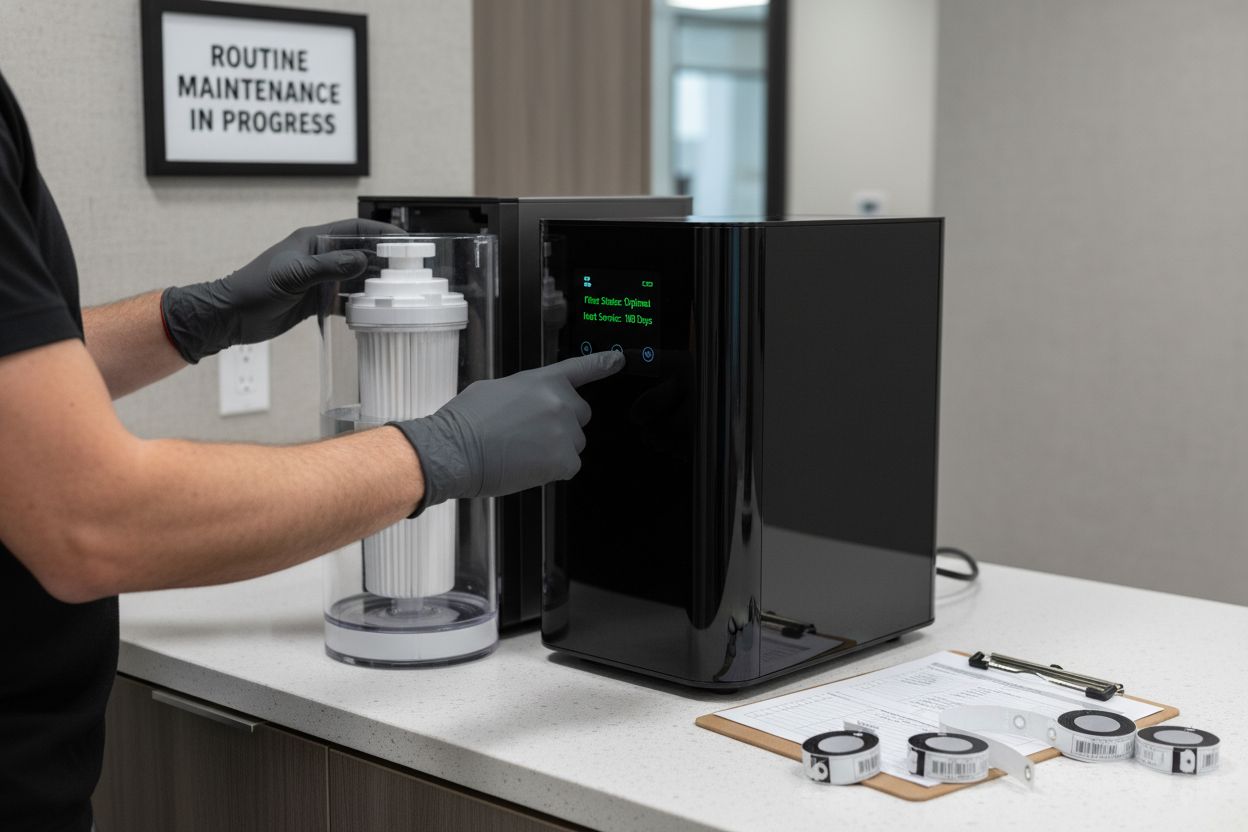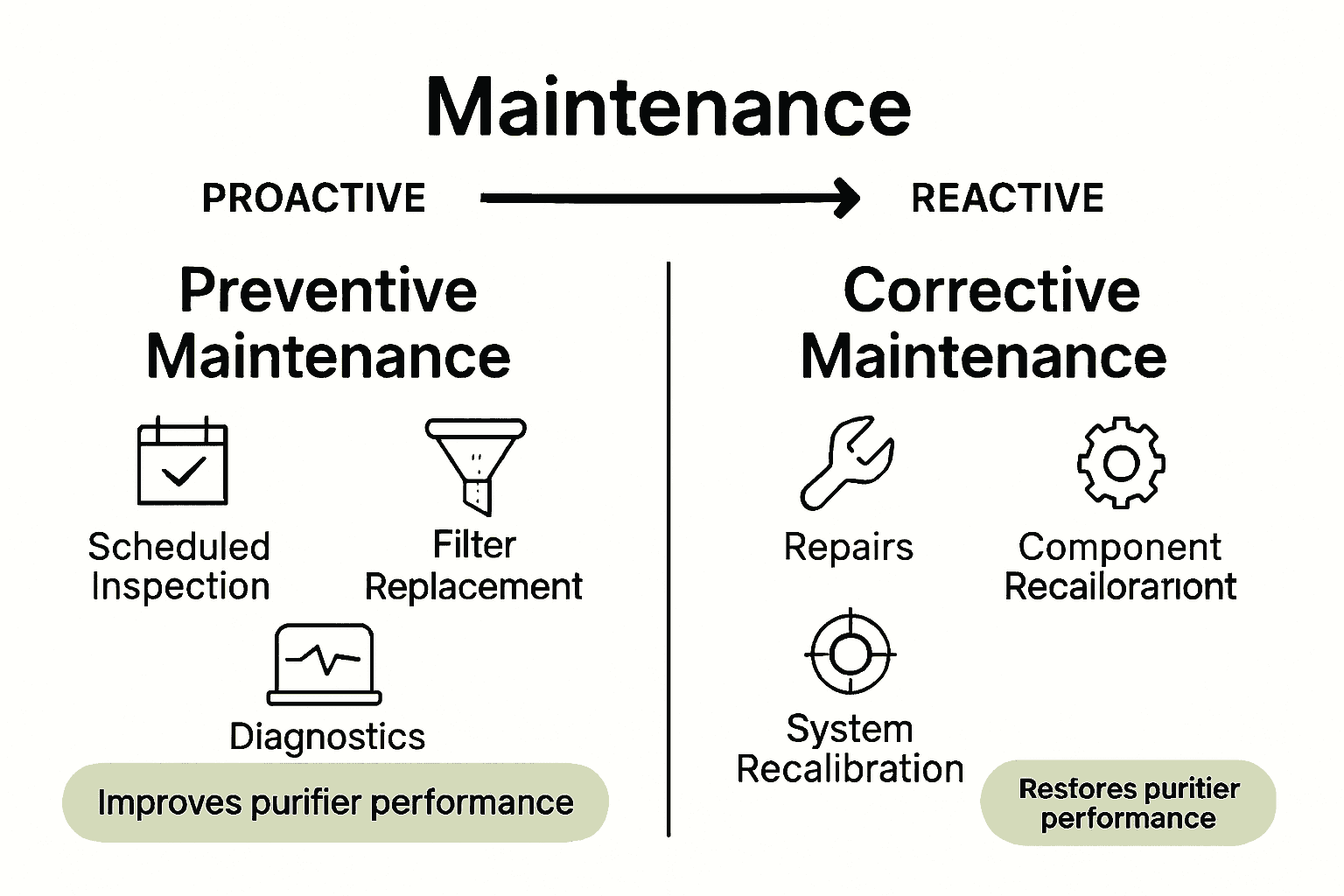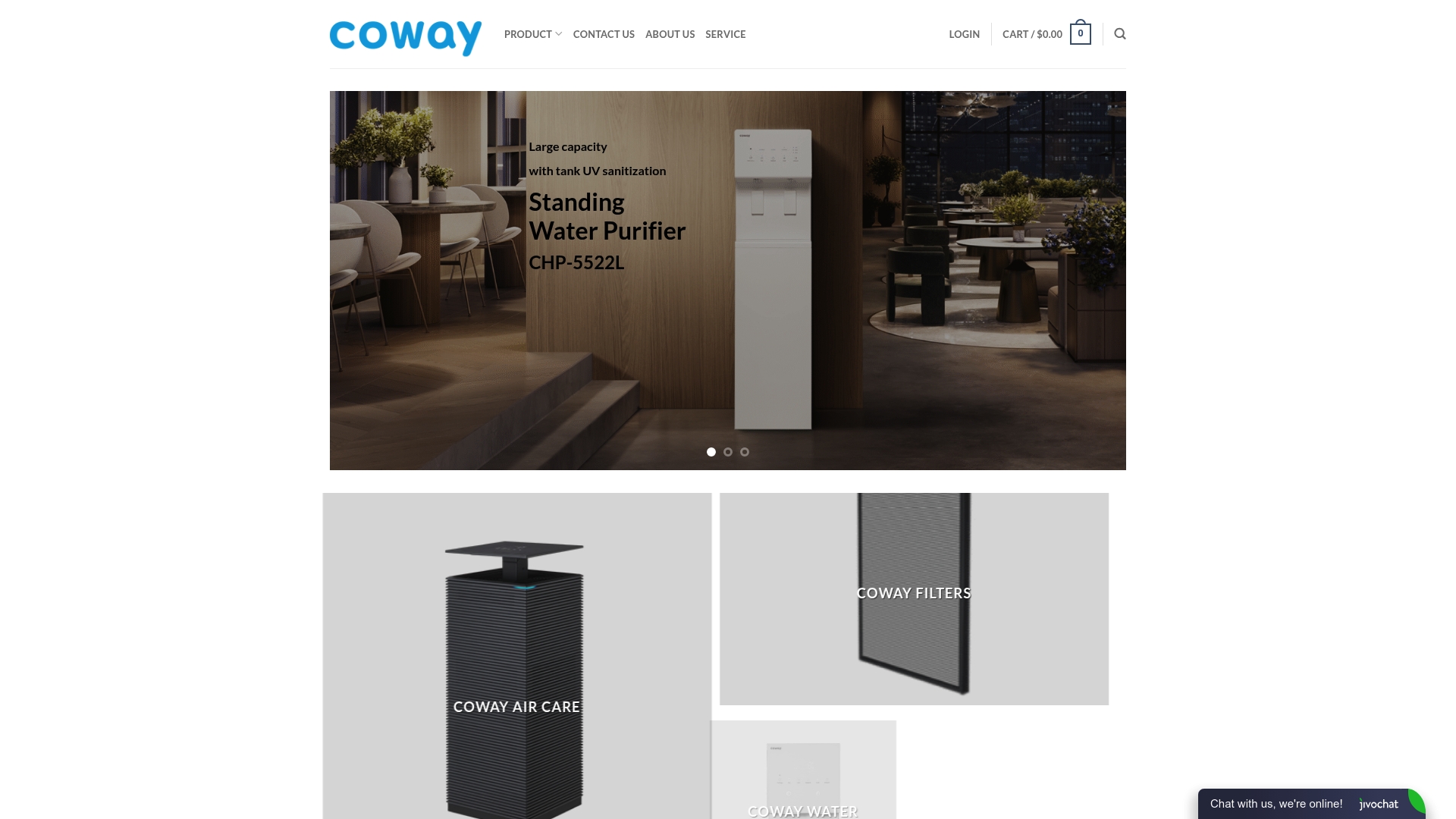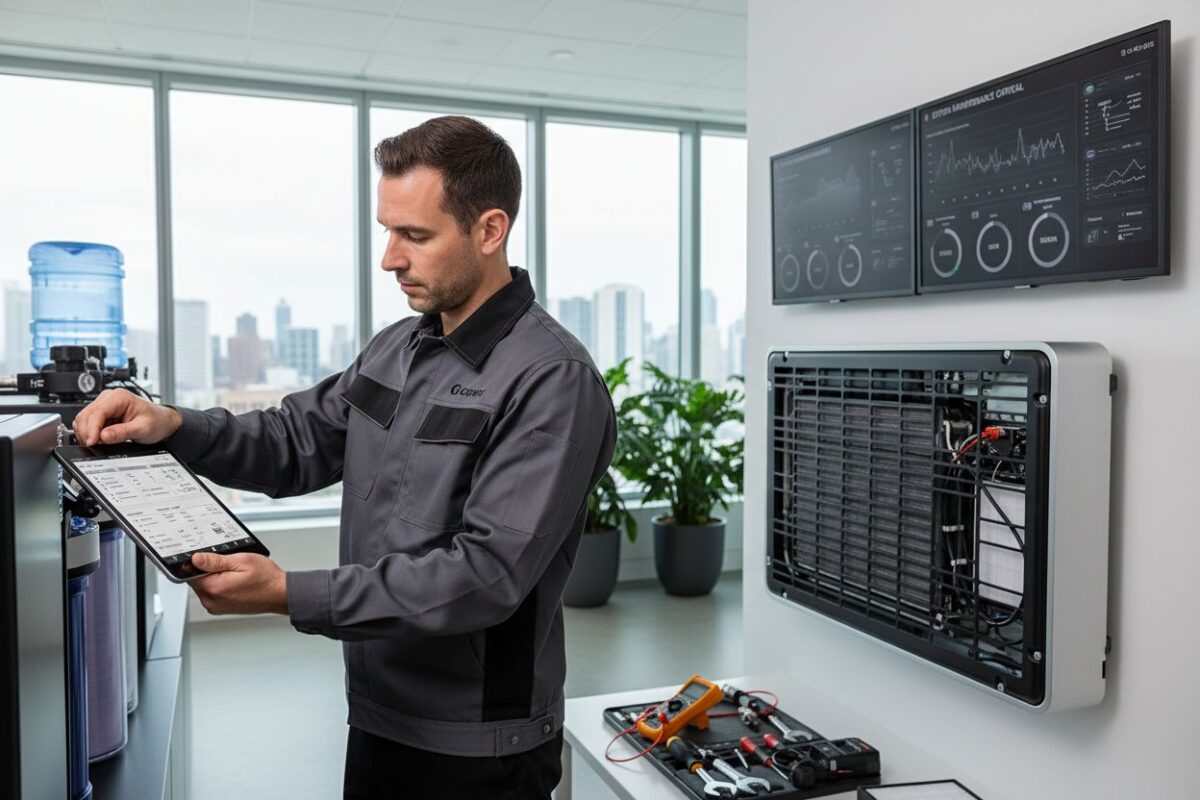Uncategorized
Complete Guide to Maintenance in Purifier Performance
Did you know that up to 70 percent of purifier failures are linked to poor maintenance? Many people depend on water and air purifiers for a healthier home, yet overlook the vital role regular upkeep plays in keeping these systems running strong. Understanding how maintenance affects purifier performance, efficiency, and even your health can protect both your investment and your well-being in ways that are easy to put into practice.
Table of Contents
- Defining Maintenance In Purifier Performance
- Types Of Maintenance For Purifiers
- How Maintenance Impacts Purifier Efficiency
- Health And Safety Implications Of Maintenance
- Best Maintenance Practices For Optimal Results
Key Takeaways
| Point | Details |
|---|---|
| Maintenance Is Essential | Regular maintenance is crucial for optimizing the performance and longevity of water and air purifiers. It includes preventive and corrective strategies to ensure effective filtration. |
| Preventive vs. Corrective Maintenance | Preventive maintenance focuses on proactive measures to avert issues, while corrective maintenance addresses problems after they arise. Balancing both strategies enhances system reliability. |
| Impact on Efficiency | Consistent maintenance significantly enhances purifier efficiency, preventing performance degradation and health risks associated with contaminants. Regular inspections and timely component replacements are key. |
| Health and Safety Considerations | Proper maintenance directly impacts indoor air quality and water safety, helping mitigate health risks associated with poorly maintained purification systems. Prioritizing maintenance fosters healthier environments. |
Defining Maintenance in Purifier Performance
Maintenance in purifier performance represents a systematic approach to ensuring optimal functionality, reliability, and longevity of water and air filtration systems. According to research from maintenance engineering, maintenance fundamentally involves functional checks, servicing, repairing, or replacing necessary components to restore a unit’s specified performance capabilities.
At its core, purifier maintenance encompasses several critical dimensions. These include preventive strategies that identify potential issues before they escalate, corrective interventions that restore system functionality after detecting performance problems, and proactive monitoring that tracks the purifier’s ongoing health. Understanding the Role of Maintenance in Purifiers highlights how regular attention can significantly extend equipment lifespan and maintain peak filtration efficiency.
The primary objectives of maintenance in purifier performance revolve around three key goals: preserving system integrity, preventing unexpected failures, and optimizing operational performance. Corrective maintenance, as defined by technical standards, specifically aims to restore an asset to a condition where it can perform its intended function after detecting operational anomalies. This approach ensures that water and air purification systems continue delivering clean, safe environments for users by addressing issues promptly and comprehensively.
While maintenance might seem complex, it fundamentally breaks down into predictable, manageable processes. Regular inspections, timely filter replacements, system calibration, and performance diagnostics form the backbone of effective purifier maintenance. By understanding and implementing these strategies, users can protect their investment and guarantee consistent, high-quality filtration performance.

Types of Maintenance for Purifiers
Maintenance for purifiers can be strategically categorized into distinct approaches that address different operational needs and system requirements. According to maintenance research, these primary types include preventive maintenance and corrective maintenance, each serving unique purposes in preserving purifier performance and reliability.
Preventive maintenance represents a proactive strategy designed to systematically inspect, service, and address potential issues before they escalate into significant problems. This approach involves scheduled interventions like regular filter replacements, system diagnostics, and comprehensive performance evaluations. 7 Essential Steps for Your Purifier Maintenance Checklist provides an excellent framework for implementing these critical preventive measures.
Conversely, corrective maintenance focuses on responding to detected system failures or performance degradation.
Here is a comparison of preventive and corrective maintenance approaches for purifiers:
| Maintenance Type | Key Focus | Typical Tasks | Main Benefits |
|---|---|---|---|
| Preventive | Proactive issue avoidance | Scheduled inspections Filter replacement System diagnostics |
Extends lifespan Reduces failures |
| Corrective | Restoring functionality | Component repairs System recalibration Addressing breakdowns |
Restores performance Minimizes downtime |
| As technical standards define, this type of maintenance aims to restore a purification system to its intended functional state after identifying operational anomalies. Corrective interventions might include component replacements, system recalibration, or comprehensive repairs that address specific performance issues detected during routine monitoring. |
Understanding these maintenance types empowers users to develop a comprehensive approach to purifier care. By balancing preventive strategies with responsive corrective actions, individuals can optimize system longevity, maintain peak filtration efficiency, and protect their investment in water and air purification technologies.
Regular monitoring, timely interventions, and a proactive mindset form the cornerstone of effective purifier maintenance across both preventive and corrective domains.

How Maintenance Impacts Purifier Efficiency
Purifier efficiency is directly tied to consistent and strategic maintenance practices that ensure optimal performance and longevity of filtration systems. Research demonstrates that regular maintenance plays a critical role in sustaining the effectiveness of water and air purification technologies, ultimately protecting users from potential contaminants and performance degradation.
According to scientific studies, timely filter replacements and systematic checks are fundamental to maintaining peak purification efficiency. Understanding Why Regular Purifier Maintenance Matters highlights how neglecting maintenance can dramatically reduce a purifier’s ability to effectively remove particulates and impurities. Research specifically indicates that without proper maintenance, purification systems can experience significant performance drops, potentially compromising their core filtration capabilities.
Key maintenance factors that directly impact purifier efficiency include filter condition, system cleanliness, and component integrity. Particulate pollution research demonstrates that degraded filters can substantially reduce air and water purification effectiveness. When filters become clogged or worn, the system must work harder, consuming more energy while simultaneously providing less effective filtration. This decreased performance not only reduces overall system efficiency but can also increase operational costs and potential health risks.
Maintaining high purifier efficiency requires a proactive approach. Regular inspections, timely component replacements, and comprehensive system diagnostics form the cornerstone of optimal performance. By implementing a structured maintenance strategy, users can ensure their purification systems operate at maximum capacity, delivering clean, safe water and air while minimizing long-term operational expenses and potential system failures.
Health and Safety Implications of Maintenance
Indoor air quality and water safety are intimately connected to the consistent maintenance of purification systems, representing critical health considerations for individuals and communities. Proper maintenance goes far beyond mechanical upkeep, directly influencing the fundamental health and safety of those who rely on these essential filtration technologies.
Research in public health underscores the profound impact of well-maintained purification systems. Understanding the Role of Service in Purifier Lifespan illuminates how regular maintenance can prevent the accumulation of harmful contaminants that potentially compromise respiratory and digestive health. Scientific studies specifically highlight that neglected purifiers can become breeding grounds for bacteria, mold, and other microorganisms that pose significant health risks.
In educational and professional environments, maintenance takes on even greater significance. Research demonstrates that well-maintained air purification systems can substantially reduce airborne particulates, allergens, and potential pathogens. This is particularly crucial in settings with high human traffic, where the concentration of respiratory droplets and potential contaminants can dramatically impact overall health and performance. Unmaintained systems not only fail to filter effectively but can potentially recirculate concentrated pollutants, creating an environment more hazardous than non-filtered spaces.
The health and safety implications of maintenance extend beyond immediate filtration performance. Regular system checks, filter replacements, and comprehensive diagnostics serve as preventative measures that protect users from potential long-term health complications. By prioritizing maintenance, individuals and organizations demonstrate a commitment to creating safe, healthy environments that proactively mitigate potential health risks associated with poor air and water quality.
Best Maintenance Practices for Optimal Results
Effective maintenance represents a systematic approach to preserving purifier performance, combining proactive strategies and precise technical interventions. The cornerstone of successful maintenance lies in developing a comprehensive, consistent routine that addresses both preventative and corrective aspects of system care.
Research consistently emphasizes the importance of establishing a structured maintenance schedule. 7 Essential Steps for Your Purifier Maintenance Checklist provides critical insights into developing an effective maintenance protocol. Key best practices include:
- Regular filter inspections and timely replacements
- Comprehensive system diagnostics
- Cleaning of internal components
- Monitoring performance metrics
- Tracking system age and component wear
Scientific studies highlight that combining mechanical maintenance with systematic monitoring significantly enhances purification system effectiveness. Maintenance goes beyond simple component replacement, requiring a holistic approach that considers system integration, environmental factors, and specific usage patterns. Professional-grade maintenance involves understanding the intricate interactions between different system components and preemptively addressing potential performance degradation.
Ultimately, optimal maintenance is about creating a proactive culture of care. By implementing regular inspections, utilizing diagnostic tools, and staying attuned to system performance, users can extend their purifier’s lifespan, maintain peak efficiency, and ensure consistent protection against environmental contaminants. The investment in comprehensive maintenance pays dividends through improved system reliability, reduced long-term operational costs, and sustained high-quality filtration performance.
Keep Your Purifiers Performing at Their Best with Expert Care
If you want to avoid costly repairs and keep your water and air purifiers running smoothly, understanding the importance of regular maintenance is key. This guide highlights how routine checks, timely filter replacements, and attentive servicing prevent performance drops and protect your health. By addressing common challenges like clogged filters and system wear, you ensure your purifier delivers clean, safe water and air every day.

Discover a wide selection of Coway purifiers designed with advanced filtration technology and built-in maintenance support. Visit Uncategorized Archives – Coway Water Purifier to explore models that include free installation and maintenance options so you can enjoy peace of mind now. Take control of your home environment today by visiting https://cowayswaterpurifier.com and experience how proactive care makes a real difference.
Frequently Asked Questions
What are the key dimensions of maintenance in purifier performance?
Maintenance in purifier performance includes preventive strategies to identify issues before they escalate, corrective interventions for restoring functionality, and proactive monitoring to track ongoing health of the system.
How does preventive maintenance differ from corrective maintenance for purifiers?
Preventive maintenance focuses on proactive issue avoidance through scheduled tasks like inspections and filter replacements, while corrective maintenance responds to identified failures to restore system functionality.
What factors impact the efficiency of water and air purifiers?
Key factors include filter condition, system cleanliness, and component integrity. Neglected maintenance can lead to clogged filters, which reduce filtration effectiveness and increase operational costs.
Why is regular maintenance crucial for health and safety regarding purifiers?
Regular maintenance prevents the buildup of harmful contaminants that can compromise health. Well-maintained purification systems improve indoor air quality and ensure safe drinking water, effectively reducing health risks associated with air and water pollutants.
Recommended
- Understanding the Role of Service in Purifier Lifespan – Coway Water Purifier
- Understanding the Role of Maintenance in Purifiers – Coway Water Purifier
- 7 Essential Steps for Your Purifier Maintenance Checklist – Coway Water Purifier
- Understanding Why Regular Purifier Maintenance Matters – Coway Water Purifier

